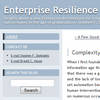 Immediately after September 11, 2001, “critical infrastructure” and “vulnerability” seemed to be the new buzzwords. More recently “resilience” has been added to that list, and for a good reason. In a business sense, resilience is the ability to recover from any unforeseen event and how quickly one can return to normal day-to-day operations. Probably the most vulnerable and most critical infrastructure in our time are global computer networks, such as the Internet.
Immediately after September 11, 2001, “critical infrastructure” and “vulnerability” seemed to be the new buzzwords. More recently “resilience” has been added to that list, and for a good reason. In a business sense, resilience is the ability to recover from any unforeseen event and how quickly one can return to normal day-to-day operations. Probably the most vulnerable and most critical infrastructure in our time are global computer networks, such as the Internet.
Enterprise Resilience
In an article in the Enterprise Resilience Management Blog, highlights how the key to resilience is not only understanding how systems work but how they break, and how being able to think outside of the proverbial box and seeing potential challenges before they emerge is one of key elements in building enterprise resilience. To think the unthinkable, to plan for the unthinkable is maybe not what is most on people’s mind and more often than not, it is only after a crisis that our thinking shifts. Then however, it may be too late.
Are roads more important than computers?
While computers are crucial to many businesses and ever so part of their critical infrastructure, what about roads? Which is more important – or ‘critical’ – road networks or computers?
What if one day you could no longer use your computer or the Internet for one month, but you could still go anywhere by car? Or what if one day you could no longer go anywhere by car for one month, but you still had your computer or the Internet up and running, which would be worse?
I think roads are more important.
When disaster strikes…
…what happens to the transportation infrastructure, and how does one recover? A session at TRB2009 looked at just that.
Links
- Enterprise Resilience Management Blog: Complexity and Resilience
Related
- husdal.com: Are roads more important than computers?












